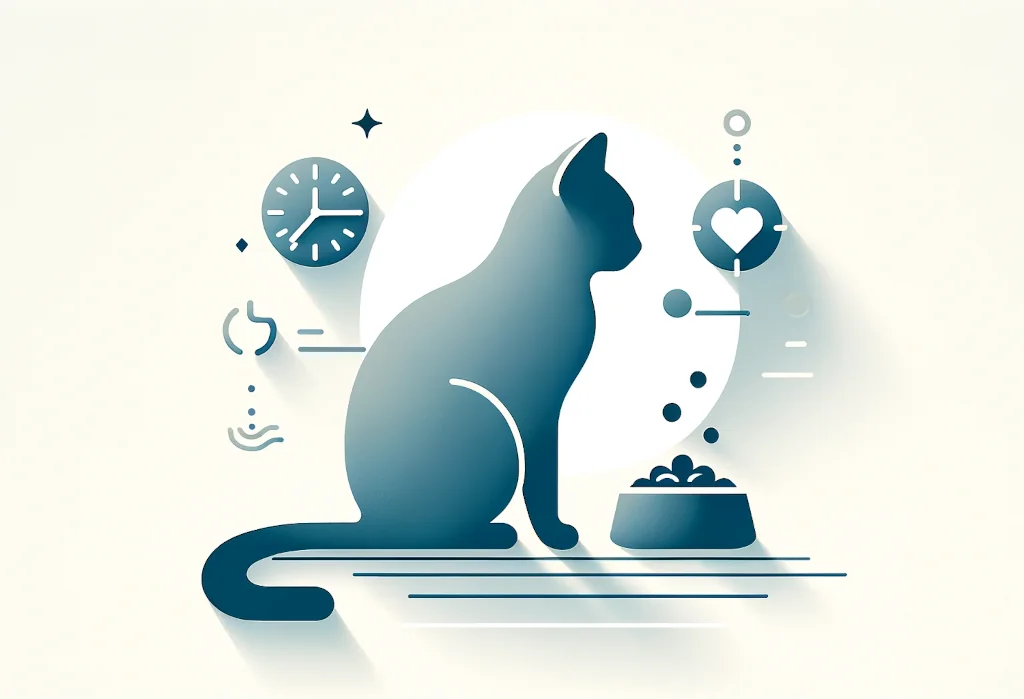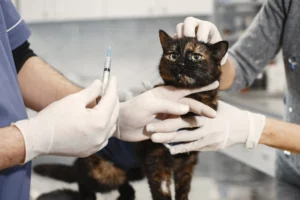Are you wondering if you’re overdoing it with the kibble, or if your feline friend is possibly the most well-fed cat on the block? Navigating the fine line between treating your cat and overfeeding them can be trickier than convincing them to stay off the kitchen counter.
This post is your go-to guide for feeding your purring companion just right, without the guesswork.
Key takeaways:
- Tailor your cat’s diet to their age, activity level, and health, measuring food with a cup and preferring scheduled meals over free-feeding.
- Kittens require more frequent and nutrient-dense meals; consult a vet for portion sizes and adopt a gradual feeding scale from milk to solid food as they grow.
- Monitor your cat’s weight, appetite, and litter box activity to ensure their diet is on track, and adjust food type or amount accordingly.
Is There a “One Size Fits All” for Feeding Cats?
Not a chance! Cats are like snowflakes, each one unique, and their dietary needs are just as individualized.
Age, activity level, and health status are the tailors measuring out the perfect feeding plan for your feline. Kittens are little balls of energy that generally need more calories to support their growth and playfulness. Adult cats may require less food, especially if they’re indoor lounge lizards rather than outdoor adventurers. Senior cats might need a diet that’s easy to digest and supportive of joint health.
Understanding your cat’s specific needs is crucial because the wrong amount of food can lead to undernourishment or obesity—a true cat-astrophe for their health. So, the next time you find yourself scratching your head at the pet store aisle, remember: there’s no universal feeding guideline here; bespoke is the word!
How Can You Determine the Right Portion Size for Your Cat?
To figure out the right portion size for your fuzzy friend, you’ll need to put on your detective hat. First off, weigh your cat (without the fluff factor). Then, consider the type of food: wet food typically has fewer calories per gram compared to dry kibble, so portion sizes will vary.
Your vet is your partner in crime when it comes to nailing down the specifics. They can offer guidelines tailored to your kitty’s needs. But here’s a nugget of wisdom to chew on: always measure your cat’s food using an actual measuring cup, rather than eyeballing it. And while the ‘free-feeding’ buffet might sound like cat heaven, it’s often a one-way ticket to weight gain. So, let’s keep those portions in check!
What’s the Ideal Feeding Schedule for Adult Cats?
Finding the sweet spot for feeding your adult cat is a bit like finding the purr-fect nap spot—it’s got to be just right.
It’s generally recommended that adult cats eat twice a day. This mimics their natural hunting behavior: stalk, chase, eat, nap, repeat. It’s a routine that can help stave off boredom and keep their weight stable.
But what about free-feeding versus scheduled meals? Scheduled feeding times (think breakfast and dinner) can help prevent overeating. Plus, it’s a great way to monitor your cat’s appetite – a key indicator of their well-being. Free-feeding can be convenient, but it often leads to an ‘eat because it’s there’ mentality.
So, consider weaving mealtime into your daily rituals. It’s not just about the food; it’s also quality time with your furball. And while the food dish might not be empty after each meal, that’s OK—cats usually eat smaller amounts throughout the day. This way, you’re tuned into their needs without encouraging an all-day buffet.
Remember, a happy cat is one that’s well-fed, not overfed. There’s more to come on keeping your feline friend fit and healthy, so stay tuned for more insights and tips!
Related: Can you feed your cat chocolate cake?
Can Kittens Eat the Same Amount as Adult Cats?
Absolutely not! Kittens are like little bundles of energy with teeny-tiny tummies, but their nutritional needs are huge. They’re growing at warp speed, so they need more calories per pound than an adult cat. Here’s the scoop on how to feed these furballs:
- Newborn to 1 month: Mama’s milk is the cat’s meow! But if that’s not an option, a kitten milk replacer will do the trick. Feed them every 2-4 hours round the clock.
- 1 to 4 months: These cuties are ready to start nibbling on solid food. Gradually introduce kitten-specific dry or wet food four times a day.
- 4 to 6 months: At this stage, your kitten is like a teenager. Feed them three times a day with a balanced kitten chow that supports their growth spurt.
- 6 to 12 months: You can ease into feeding them twice daily, but stick to a kitten formula that continues accommodating their developmental needs.
Remember, their nutritional needs vary with their breed, size, and energy levels. Listen to your little purr machine—they’ll tell you if their tummies aren’t jiving with the feeding regimen.
Are there Certain Types of Food That Require Different Feeding Approaches?
You bet there are! There’s no one-size-fits-all when it comes to feeding your whiskered friend. The approach changes like day and night between food types:
- Dry food: It’s convenient, for sure. Many cat parents opt for free-feeding their non-finicky felines but watch out for overeating. Portion control can help maintain a healthy weight.
- Wet food: This hydrating option is chock-full of moisture, which can benefit kitty’s urinary health. Stick to feeding guidelines on the label and keep a consistent schedule, typically twice a day.
- Raw diets: With debates often hotter than a cat on a hot tin roof, raw diets should be carefully balanced. Because they’re perishable, feed your cat in controlled amounts and discard any uneaten portions promptly to prevent spoilage.
- Homemade food: Tread carefully here! Balance is critical. Before you go all ‘Chef Cat-r-dee’, consult with a vet or a nutritionist to ensure your home-cooked dishes meet all kitty’s needs.
Pro Tip: A unique nugget of advice? For cats on wet food diets, try using ice cube trays to freeze portion-sized servings. Thaw them out before feeding time for a convenient and controlled way to serve up their meals.
What Signs Indicate You’re Feeding Your Cat Correctly or Incorrectly?
Keep your eyes peeled for clues your cat is leaving you. If Mr. Whiskers is in tip-top shape, his coat will be as shiny as a newly minted dime, and he’ll have the energy of a kitten in a yarn shop. But that’s not all:
- A healthy appetite – A clean plate club member is a good sign.
- Ideal body weight – Ribs should be palpable but not visible. Check out the chart by AAHA for reference.
- Litter box regularity – What goes in must come out, right? But if the litter box looks like a disaster zone or a ghost town, chat with your vet.
On the flip side, if you’ve got a kitty that’s packing on the pounds or is thin as a rail, you may need to adjust the meal plan. Lethargy, a dull coat, or digestive issues could also scream “feeding faux pas!”
Remember, variety is the spice of life, even in your writing. Mix and match your sentence structures, and sprinkle in some flavorful vocab to keep your reader engaged. Taking your cat for regular check-ups to monitor their health status is key. After all, your vet’s expertise mixed with your observant eye makes for the puuurfect combo to keep your furball fed just right.
Alex, a passionate animal lover, has experience in training and understanding animal behavior. As a proud pet parent to two dogs and three cats, he founded AnimalReport.net to share insights from animal experts and expand his knowledge of the animal kingdom.





